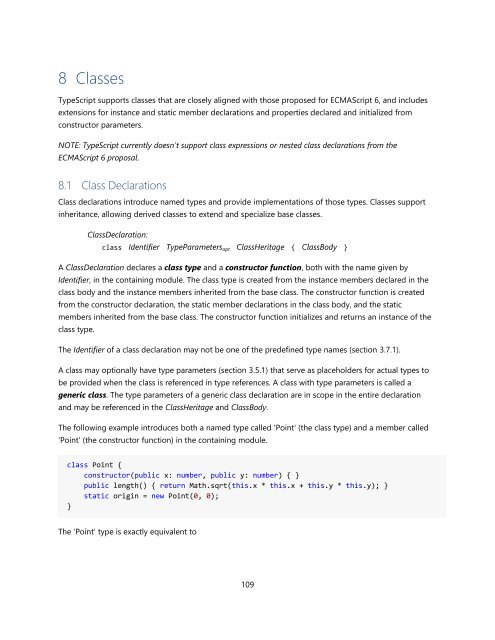TypeScript Language Specification v1.5
TypeScript Language Specification v1.5
TypeScript Language Specification v1.5
Create successful ePaper yourself
Turn your PDF publications into a flip-book with our unique Google optimized e-Paper software.
8 Classes<br />
<strong>TypeScript</strong> supports classes that are closely aligned with those proposed for ECMAScript 6, and includes<br />
extensions for instance and static member declarations and properties declared and initialized from<br />
constructor parameters.<br />
NOTE: <strong>TypeScript</strong> currently doesn't support class expressions or nested class declarations from the<br />
ECMAScript 6 proposal.<br />
8.1 Class Declarations<br />
Class declarations introduce named types and provide implementations of those types. Classes support<br />
inheritance, allowing derived classes to extend and specialize base classes.<br />
ClassDeclaration:<br />
class Identifier TypeParameters opt ClassHeritage { ClassBody }<br />
A ClassDeclaration declares a class type and a constructor function, both with the name given by<br />
Identifier, in the containing module. The class type is created from the instance members declared in the<br />
class body and the instance members inherited from the base class. The constructor function is created<br />
from the constructor declaration, the static member declarations in the class body, and the static<br />
members inherited from the base class. The constructor function initializes and returns an instance of the<br />
class type.<br />
The Identifier of a class declaration may not be one of the predefined type names (section 3.7.1).<br />
A class may optionally have type parameters (section 3.5.1) that serve as placeholders for actual types to<br />
be provided when the class is referenced in type references. A class with type parameters is called a<br />
generic class. The type parameters of a generic class declaration are in scope in the entire declaration<br />
and may be referenced in the ClassHeritage and ClassBody.<br />
The following example introduces both a named type called 'Point' (the class type) and a member called<br />
'Point' (the constructor function) in the containing module.<br />
class Point {<br />
constructor(public x: number, public y: number) { }<br />
public length() { return Math.sqrt(this.x * this.x + this.y * this.y); }<br />
static origin = new Point(0, 0);<br />
}<br />
The 'Point' type is exactly equivalent to<br />
109


















